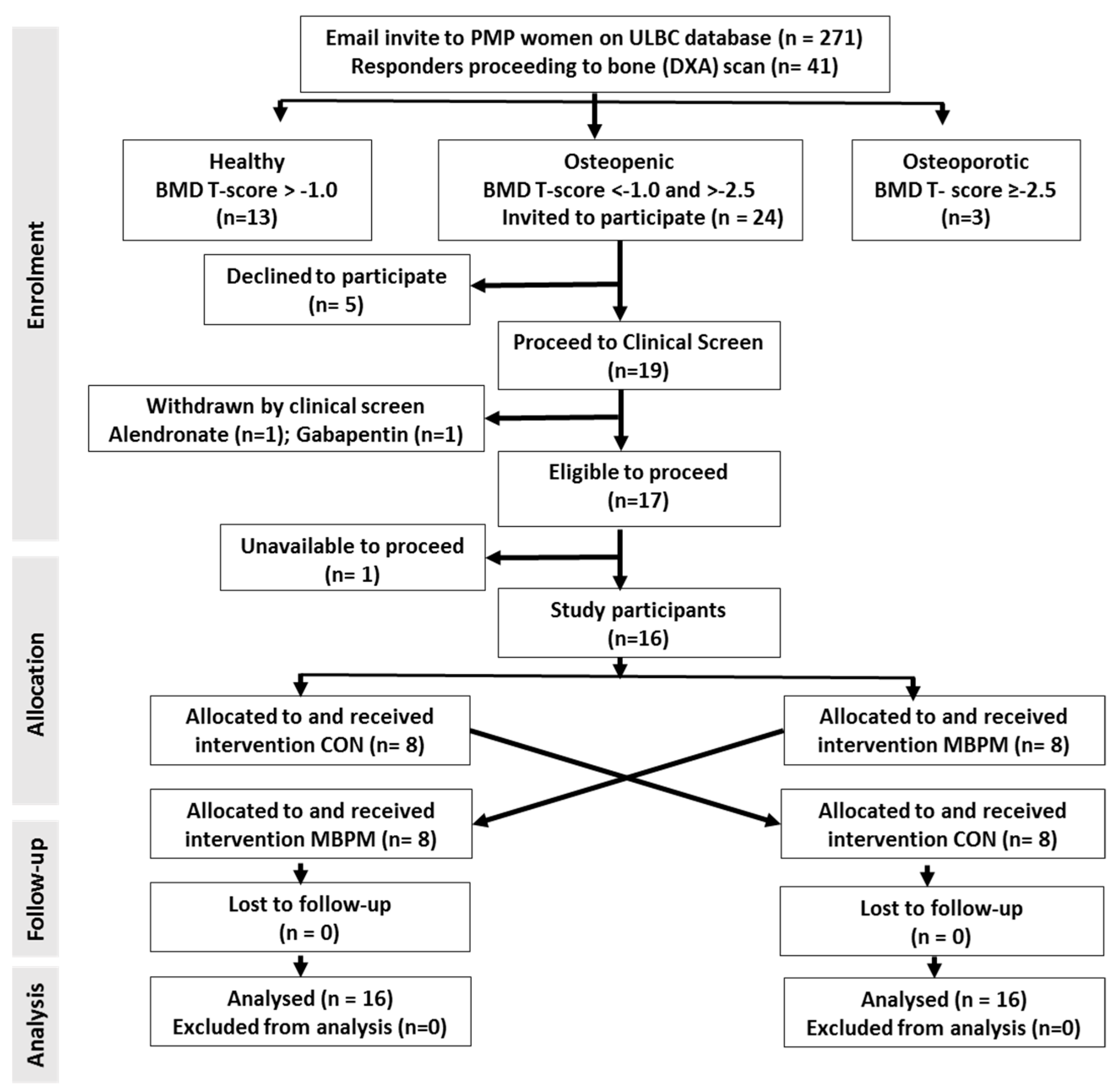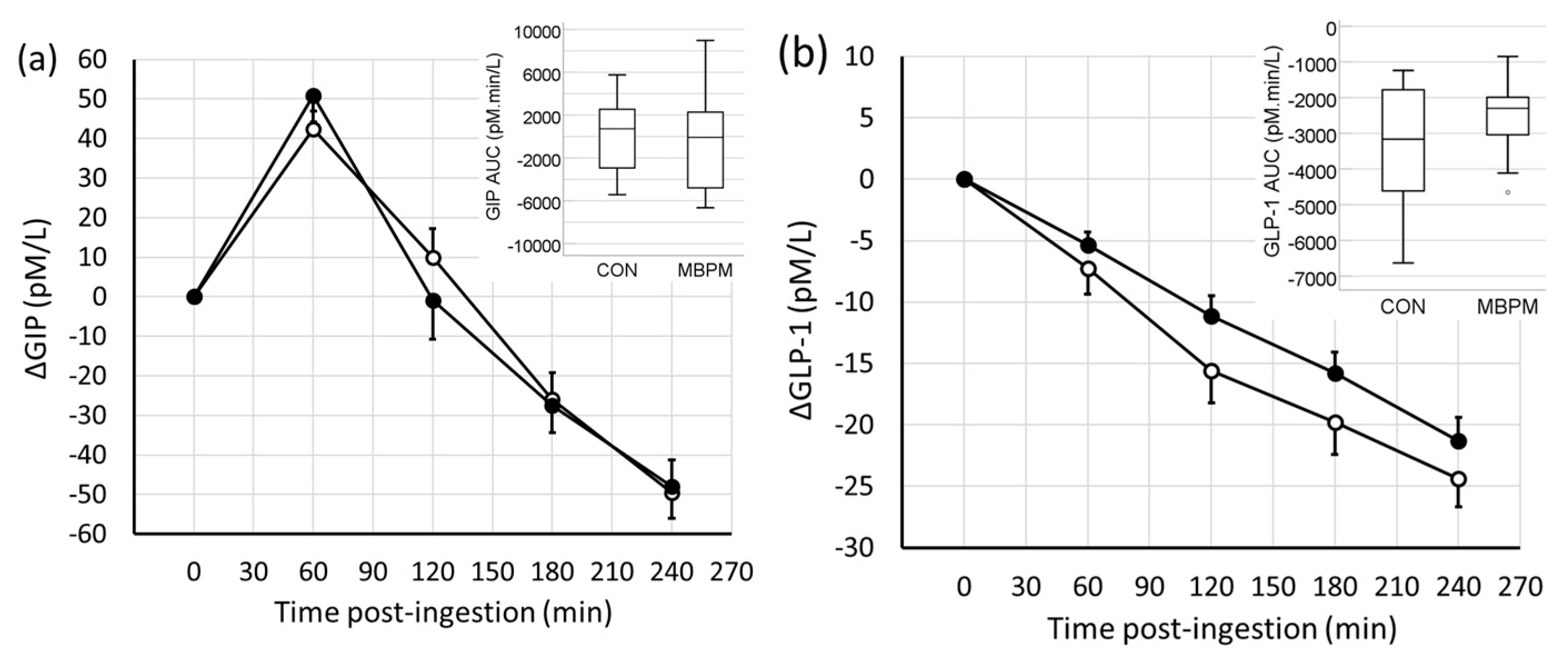Temporal Change in Biomarkers of Bone Turnover Following Late Evening Ingestion of a Calcium-Fortified, Milk-Based Protein Matrix in Postmenopausal Women with Osteopenia
Abstract
:1. Introduction
2. Materials and Methods
2.1. Participant Recruitment and Progression
2.2. Study Design
2.3. Dietary Intake and Standardized Diets for the Intervention
2.4. Trial Protocol and Procedures
2.5. Statistical Analysis
3. Results
3.1. Subject Characteristics
3.2. Dietary Intake
3.3. Enterogastric Response to Feeding
3.4. Parathyroid Hormone and Bone Turnover Marker Response to Feeding
3.5. Urinary 24 h BTM Excretion
4. Discussion
5. Conclusions
Supplementary Materials
Author Contributions
Funding
Acknowledgments
Conflicts of Interest
References
- Bailey, A.J.; Sims, T.J.; Ebbesen, E.N.; Mansell, J.P.; Thomsen, J.S.; Mosekilde, L. Age-related changes in the biochemical properties of human cancellous bone collagen: Relationship to bone strength. Calcif. Tissue Int. 1999, 65, 203–210. [Google Scholar] [CrossRef] [PubMed]
- Heaney, R.P. Is the paradigm shifting? Bone 2003, 33, 457–465. [Google Scholar] [CrossRef]
- Cosman, F.; de Beur, S.J.; LeBoff, M.S.; Lewiecki, E.M.; Tanner, B.; Randall, S.; Lindsay, R. Clinician’s Guide to Prevention and Treatment of Osteoporosis. Osteoporos. Int. 2014, 25, 2359–2381. [Google Scholar] [CrossRef] [PubMed]
- Szulc, P.; Naylor, K.; Hoyle, N.R.; Eastell, R.; Leary, E.T. Use of CTX-I and PINP as bone turnover markers: National Bone Health Alliance recommendations to standardize sample handling and patient preparation to reduce pre-analytical variability. Osteoporos. Int. 2017, 28, 2541–2556. [Google Scholar] [CrossRef] [PubMed]
- Bjarnason, N.H.; Henriksen, E.E.G.; Alexandersen, P.; Christgau, S.; Henriksen, D.B.; Christiansen, C. Mechanism of circadian variation in bone resorption. Bone 2002, 30, 307–313. [Google Scholar] [CrossRef]
- Redmond, J.; Fulford, A.J.; Jarjou, L.; Zhou, B.; Prentice, A.; Schoenmakers, I. Diurnal Rhythms of Bone Turnover Markers in Three Ethnic Groups. J. Clin. Endocrinol. Metab. 2016, 101, 3222–3230. [Google Scholar] [CrossRef] [PubMed] [Green Version]
- Qvist, P.; Christgau, S.; Pedersen, B.J.; Schlemmer, A.; Christiansen, C. Circadian variation in the serum concentration of C-terminal telopeptide of type I collagen (serum CTx): Effects of gender, age, menopausal status, posture, daylight, serum cortisol, and fasting. Bone 2002, 31, 57–61. [Google Scholar] [CrossRef]
- Pedersen, B.J.; Schlemmer, A.; Rosenquist, C.; Hassager, C.; Christiansen, C. Circadian rhythm in type I collagen formation in postmenopausal women with and without osteopenia. Osteoporos. Int. 1995, 5, 472–477. [Google Scholar] [CrossRef]
- Henriksen, D.B.; Alexandersen, P.; Bjarnason, N.H.; Vilsbøll, T.; Hartmann, B.; Henriksen, E.E.; Byrjalsen, I.; Krarup, T.; Holst, J.J.; Christiansen, C. Role of gastrointestinal hormones in postprandial reduction of bone resorption. J. Bone Miner. Res. 2003, 18, 2180–2189. [Google Scholar] [CrossRef]
- Bollag, R.J.; Zhong, Q.; Ding, K.H.; Phillips, P.; Zhong, L.; Qin, F.; Cranford, J.; Mulloy, A.L.; Cameron, R.; Isales, C.M. Glucose-dependent insulinotropic peptide is an integrative hormone with osteotropic effects. Mol. Cell. Endocrinol. 2001, 177, 35–41. [Google Scholar] [CrossRef]
- Zhong, Q.; Itokawa, T.; Sridhar, S.; Ding, K.H.; Xie, D.; Kang, B.; Bollag, W.B.; Bollag, R.J.; Hamrick, M.; Insogna, K.; et al. Effects of glucose-dependent insulinotropic peptide on osteoclast function. Am. J. Physiol. Endocrinol. Metab. 2007, 292, E543–E548. [Google Scholar] [CrossRef] [PubMed]
- Nissen, A.; Christensen, M.; Knop, F.K.; Vilsboll, T.; Holst, J.J.; Hartmann, B. Glucose-dependent insulinotropic polypeptide inhibits bone resorption in humans. J. Clin. Endocrinol. Metab. 2014, 99, E2325–E2329. [Google Scholar] [CrossRef] [PubMed]
- U.S. Department of Health and Human Services and U.S. Department of Agriculture. 2015–2020 Dietary Guidelines for Americans, 8th ed.December 2015. Available online: http://health.gov/dietaryguidelines/2015/guidelines/ (accessed on 22 June 2019).
- McKane, W.R.; Khosla, S.; Egan, K.S.; Robins, S.P.; Burritt, M.F.; Riggs, B.L. Role of calcium intake in modulating age-related increases in parathyroid function and bone resorption. J. Clin. Endocrinol. Metab. 1996, 81, 1699–1703. [Google Scholar] [CrossRef]
- Aerssens, J.; Declerck, K.; Maeyaert, B.; Boonen, S.; Dequecker, J. The effect of modifying dietary calcium intake pattern on the circadian rhythm of bone resorption. Calcif. Tissue. Int. 1999, 65, 34–40. [Google Scholar] [CrossRef] [PubMed]
- Heaney, R.P. Calcium, Dairy Products and Osteoporosis. J. Am. Coll. Nutr. 2013, 19, 83S–99S. [Google Scholar] [CrossRef]
- Thorning, T.K.; Bertram, H.C.; Bonjour, J.-P.; de Groot, L.; Dupont, D.; Feeney, E.; Ipsen, R.; Lecerf, J.M.; Mackie, A.; McKinley, M.C.; et al. Whole dairy matrix or single nutrients in assessment of health effects: Current evidence and knowledge gap. Am. J. Clin. Nutr. 2017, 105, 1033–1045. [Google Scholar] [CrossRef] [PubMed]
- Institute of Medicine, Food and Nutrition Board. Dietary Reference Intakes; National Academy Press: Washington, DC, USA, 2010. [Google Scholar]
- Shepherd, J.A.; Schousboe, J.T.; Broy, S.B.; Engelke, K.; Leslie, W.D. Executive Summary of the 2015 ISCD Position Development Conference on Advanced Measures from DXA and QCT: Fracture Prediction Beyond BMD. J. Clin. Densitom. 2015, 18, 274–286. [Google Scholar] [CrossRef]
- Tang, J.C.Y.; Dutton, J.J.; Pieca, I.; Green, D.; Washbourne, C.J.; Fraser, W.C. LC–MS/MS application for urine free pyridinoline and free deoxypyridinoline: Urine markers of collagen and bone degradation. Clin. Mass Spectrom. 2016, 1, 11–18. [Google Scholar] [CrossRef]
- Irish Universities Nutrition Alliance. 2011. Available online: http://www.iuna.net/ (accessed on 22 June 2019).
- Calbet, J.; Holst, J. Gastric emptying, gastric secretion and enterogastrone response after administration of milk proteins or their peptide hydrolysates in humans. Eur. J. Nutr. 2004, 43, 127–139. [Google Scholar] [CrossRef]
- Lacroix, I.M.E.; Li-Chan, E.C.Y. Dipeptidyl peptidase (DPP)-IV inhibitory activity of dairy protein hydrolysates. Int. Dairy J. 2012, 25, 97–102. [Google Scholar] [CrossRef]
- Power-Grant, O.B.; Bruen, C.M.; Brennan, L.; Giblin, L.; Jakeman, P.M.; Fitzgerald, D. In vitro bioactive properties of intact and enzymatically hydrolysed whey protein: Targeting the enteroinsular axis. Food Funct. 2015, 6, 972–980. [Google Scholar] [CrossRef] [PubMed]
- Gonzalez, J.T.; Stevenson, E.J. Calcium co-ingestion augments glucose-dependent insulinotrophic peptide(1–42), glucagon-like peptide-1 and insulin concentrations in humans. Eur. J. Nutr. 2014, 52, 375–385. [Google Scholar] [CrossRef] [PubMed]
- Heaney, R.P. The bone remodeling transient: Interpreting interventions involving bone-related nutrients. Nutr, Rev. 2001, 59, 327–334. [Google Scholar] [CrossRef] [PubMed]
- Zikán, V.; Haas, T.; Stepan, J.J. Acute effects in healthy women of oral calcium on the calcium-parathyroid axis and bone resorption as assessed by serum b-CrossLaps. Calc. Tissue Int. 2001, 68, 352–357. [Google Scholar] [CrossRef]
- Ledger, G.A.; Burritt, M.F.; Kao, P.C.; O’Fallon, W.M.; Riggs, B.L.; Khosla, S. Role of parathyroid hormone in mediating nocturnal and age related increases in bone resorption. J. Clin. Endocrinol. Metab. 1995, 80, 3304–3310. [Google Scholar] [CrossRef] [PubMed]
- Schlemmer, A.; Hassager, C.; Jensen, S.B.; Christiansen, C. Marked diurnal variation in urinary excretion of bone collagen crosslinks in premenopausal women. J. Clin. Endocrinol. Metab. 1992, 7, 476–480. [Google Scholar]
- Brabraj, J.A.; Smith, K.; Cuthbertson, D.J.R.; Rickhuss, P.; Dorling, J.S.; Rennie, M.J. Human bone collagen is a rapid, nutritionally modulated process. J. Bone Miner. Res. 2005, 20, 930–937. [Google Scholar] [CrossRef]
- Heaney, R.P.; Layman, D.K. Amount and type of protein influences bone health. Am. J. Clin. Nutr. 2008, 87, 1567s–1570s. [Google Scholar] [CrossRef]
- Matía-Martín, P.; Torrego-Ellacuría, M.; Larrad-Sainz, A.; Fernández-Pérez, C.; Cuesta-Triana, F.; Rubio-Herrera, M.A. Effects of Milk and Dairy Products on the Prevention of Osteoporosis and Osteoporotic Fractures in Europeans and Non-Hispanic Whites from North America: A Systematic Review and Updated Meta-Analysis. Adv. Nutr. 2019, 10 (Suppl. 2), S120–S143. [Google Scholar] [CrossRef]
- Morita, Y.; Matsuyama, H.; Serizawa, A.; Takeya, T.; Kawakami, H. Identification of angiogenin as the osteoclastic bone resorption-inhibitory factor in bovine milk. Bone 2008, 42, 380–387. [Google Scholar] [CrossRef]





| Characteristic | Unit | Mean | SD | Range |
|---|---|---|---|---|
| Age | y | 64.7 | 3.3 | 55.8 to 69.5 |
| Height | cm | 160.8 | 7.0 | 149.5 to 177.7 |
| Weight | kg | 67.2 | 10.8 | 48.0 to 91.1 |
| Body mass index | kg·m−2 | 26.0 | 4.1 | 19.9 to 37.1 |
| Fat mass | kg | 26.4 | 7.1 | 14.3 to 40.1 |
| Lean mass | kg | 38.6 | 4.2 | 31.7 to 49.1 |
| Body fat | % | 38.8 | 4.8 | 29.9 to 48.3 |
| Dual Femur | T-score | −0.81 | 0.49 | −1.5 to −0.05 |
| BMDspine (L1–L4) | T-score | −1.65 | 0.47 | −2.4 to −1.0 |
| Mean Daily Intake in MBPM Trial | |||||||
| Energy (kcal) | Protein (g) | Protein (g/kg) | Carbohydrate (g) | Fat (g) | Calcium (mg) | Vitamin D (ug) | |
| Mean | 2009 | 107.3 | 1.6 | 177.8 | 89.7 | 1679 | 9.2 |
| SD | 44 | 6.8 | 0.2 | 22.4 | 9.7 | 196 | 3.1 |
| Min | 1933 | 94.9 | 1.3 | 144.4 | 77.3 | 1345 | 3 |
| Max | 2079 | 120.3 | 2 | 217.2 | 107.7 | 2095 | 12.3 |
| Mean Daily Intake in CON Trial | |||||||
| Mean | 1994 | 85.2 | 1.3 | 203.7 | 89.7 | 804 | 8.2 |
| SD | 43 | 5.2 | 0.2 | 24 | 9.7 | 153 | 3.2 |
| Min | 1921 | 79.1 | 1 | 168.9 | 77.3 | 517 | 1.7 |
| Max | 2064 | 95.2 | 1.6 | 252.3 | 107.7 | 1013 | 11.2 |
© 2019 by the authors. Licensee MDPI, Basel, Switzerland. This article is an open access article distributed under the terms and conditions of the Creative Commons Attribution (CC BY) license (http://creativecommons.org/licenses/by/4.0/).
Share and Cite
Hettiarachchi, M.; Cooke, R.; Norton, C.; Jakeman, P. Temporal Change in Biomarkers of Bone Turnover Following Late Evening Ingestion of a Calcium-Fortified, Milk-Based Protein Matrix in Postmenopausal Women with Osteopenia. Nutrients 2019, 11, 1413. https://doi.org/10.3390/nu11061413
Hettiarachchi M, Cooke R, Norton C, Jakeman P. Temporal Change in Biomarkers of Bone Turnover Following Late Evening Ingestion of a Calcium-Fortified, Milk-Based Protein Matrix in Postmenopausal Women with Osteopenia. Nutrients. 2019; 11(6):1413. https://doi.org/10.3390/nu11061413
Chicago/Turabian StyleHettiarachchi, Manjula, Rachel Cooke, Catherine Norton, and Phil Jakeman. 2019. "Temporal Change in Biomarkers of Bone Turnover Following Late Evening Ingestion of a Calcium-Fortified, Milk-Based Protein Matrix in Postmenopausal Women with Osteopenia" Nutrients 11, no. 6: 1413. https://doi.org/10.3390/nu11061413
APA StyleHettiarachchi, M., Cooke, R., Norton, C., & Jakeman, P. (2019). Temporal Change in Biomarkers of Bone Turnover Following Late Evening Ingestion of a Calcium-Fortified, Milk-Based Protein Matrix in Postmenopausal Women with Osteopenia. Nutrients, 11(6), 1413. https://doi.org/10.3390/nu11061413






